reforestation

Making a case for forest investments in Pakistan
For stories and updates on related activities, follow us on twitter and facebook , or subscribe to our mailing list for regular updates.
Last Updated : 06-16-2024
To reforest Haiti, include Haitians in land management decisions
Haiti is a country of mountains and fields. Roughly 80 percent of the land is covered in rocky ridges, and the vast majority of rural areas are divided into small, privately-owned, cultivated plots. Haiti’s natural forests, once abundant, have gradually disappeared due to a complex mix of economic, political and demographic factors dating back 500 years. The country’s ecology is also shaped by a history of powerful storms: in October 2016, for example, Hurricane Matthew barreled across Haiti’s southern peninsula, devastating communities and the environments they depend on.
But just because Haiti’s landscape is now dominated by human activity doesn’t mean there is no room - or need - for trees.![]() In fact, trees, shrubs, and agroforestry systems cover some 30 percent of the land and play a vital role in boosting agricultural production, improving livelihoods, and strengthening ecosystems. Increasing the number of trees could multiply these benefits – but only if lands are managed in an inclusive and sustainable way.
In fact, trees, shrubs, and agroforestry systems cover some 30 percent of the land and play a vital role in boosting agricultural production, improving livelihoods, and strengthening ecosystems. Increasing the number of trees could multiply these benefits – but only if lands are managed in an inclusive and sustainable way.
“Top-down landscape projects that don’t allow communities to participate in meaningful decision making have systematically failed,” said Caroline Plante, Senior Livestock Specialist at the World Bank. “This is one of the conclusions we drew from reviewing 80 years of land management efforts in Haiti. Communities all understand the importance of trees, but they become caught in a vicious cycle of increasingly degraded lands. If we want to see widespread reforestation – which is one of the goals of the World Bank’s Resilient Productive Landscapes Project - we need engagement with both local communities and experts, taking into account socio-economic factors.”
To enable this kind of deep inclusivity, the Program on Forests (PROFOR) funded the development of a Participatory Watershed Management Planning Methodology, which was carried out by the J/P Haitian Relief Organization (J/P HRO) as part of the “Haiti Takes Root” National Reforestation Initiative. The new approach was piloted in two distinct micro-watersheds: one defined by mountain springs and highland agriculture, and the other by coastal wetlands, mangroves, and fisheries.
In phase one, the methodology focused on technical aspects, including using GIS technology to map out the geographical features of the pilot sites. Then, a team of Haitian experts – representing fields as varied as agronomy, economics, sociology, anthropology, hydrology, and ecology - conducted a rapid assessment of all the factors relevant to effective watershed management.
The next step was interviewing community members and organizing workshops with residents to better understand their needs and to benefit from their in-depth knowledge of the landscape. Participants were carefully chosen to represent a variety of views, including the opinions of women. Elected officials were also invited, not simply to witness the proceedings but also to participate in the plenary sessions.
In the last phase of the process, the expert team presented their findings and proposed actions to the communities. Suggestions included shifting away from weeded annual crops that degrade fragile slopes, and incorporating trees into cultivation areas. The group also collectively identified high-value targets for improved water management.
“This tool incorporates participation at every turn,” said Dr. Glenn Smucker, lead author of the methodology report. “It has to do with the realities of peoples’ lives where they actually live. It identifies watershed management priorities that line up with peoples’ economic motivations because something worth investing in, is something worth protecting.”
“The main idea is for people to feel as though their lives have improved after a project has been carried out,” said Tracy Kroner, Executive Director at Haiti Takes Root. “This may sound obvious, but projects often leave beneficiaries or donors disappointed. By using this tool, projects can help ensure that scarce resources are allocated in a way that is effective, inclusive, and appreciated. That way, even if a project can’t address all the challenges that communities face, they understand the reasons why and have been a part of the decision-making that led to the final outcome.”
Another important aspect of the methodology is its replicability. While the tool is specifically designed for small-scale settings with workshops of no more than 50 people at a time, its straight-forward style can easily be carried out by others.
“These materials are very succinctly organized into what is almost a checklist,” said Kroner. “You can use it as a guideline and it’s very easy to adapt, so I hope other projects will pick up on it.”
In the meantime, the J/P HRO and World Bank teams are already implementing the methodology as part of the Resilient Productive Landscapes Project. A third workshop has been carried out in the pilot areas to translate the priority activities identified by the community into a concrete investment plan.
With the 2018 Atlantic hurricane season already underway and the risks from climate change increasing all the time, the need to jump-start reforestation efforts in Haiti is more important than ever. As Smucker noted, “People have told us, ‘we’ve had three years of drought, we’ve had terrible hurricanes. What is the resource that gives us the greatest resilience? It’s trees, even the fallen ones, and perennial crops like sorghum and millet.’ Restoring the production of income-generating trees and crops is central to survival, and a big part of building people’s resilience as they anticipate more storms and droughts.”
(All photos are credited to J/P HRO.)
For stories and updates on related activities, follow us on twitter and facebook , or subscribe to our mailing list for regular updates.
Last Updated : 06-16-2024








